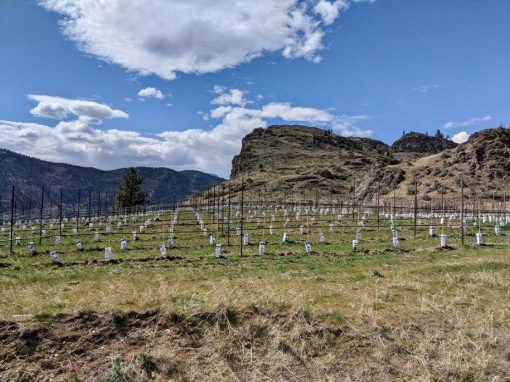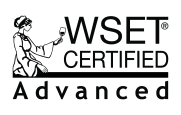By Peter Vetsch
[These bottles were provided as samples for review purposes.]
After last weekend’s right-on-cue random Calgary mid-May hailstorm-then-blizzard combo, I now feel comfortable saying that spring has finally arrived in our corner of the world, far later than it should have, as always. When things turn green and start to grow, and when the world once again sheds its winter coat for another half-turn around the sun, I tend to reach for wines of brightness, freshness. The heavy reds have their time and place, but it is not here and now. After Ray’s excellent introduction to the history and new offerings of the rapidly ascending Synchromesh Wines, and after watching my environment awaken and shift into growth mode, I needed some Riesling. Good thing I have three.

As noted in our last post, Synchromesh’s crown jewel site is the place where it all began for the winery, the Storm Haven Vineyard right near (and well above) Okanagan Falls. A subsequent acquisition of an adjacent parcel on the same hillside brought the total vineyard acreage up to 107 acres, but of that only 21 acres are planted to vines, with the rest intentionally left accessible for wildlife habitat and conservation works. This allows the Dickinson family both to help out local wildlife charities and to ensure that Storm Haven remains an active, lively, biodiverse site in which the vines are a harmonious partner instead of an invasive intruder. Altitudes range from 1300 to over 2000 feet as the vineyard rises up the base of Peach Cliff Mountain, straddling a fault line and enjoying the corresponding mineral explosion in the sandy loam soils (quartz, granite, slate, metal deposits) that goes along with such geologically interesting positioning.

Storm Haven Vineyard. Photo Credit: Andrew Melville.
Riesling makes up over 70% of the plantings here — I was honestly surprised they planted anything else at this hallowed Riesling altar, one of the top sites for this grape in the country. The remaining acreage is largely comprised of Cabernet Franc and Pinot Noir, except for a single block (0.33 acres) of own-rooted Cinsault which was planted last year. It’s safest to assume that the latter is destined for rosé, but I would absolutely buy a single-vineyard Storm Haven red Cinsault, if Synchromesh needed any further production ideas. Tonight’s Rieslings all express the site-hewn power, intensity and scope of Storm Haven, but in varying degrees. All also hew to Synchromesh’s Riesling credo of low alcohol, notable residual sugar and incisive acidity; the combined ABV of this trio of wines is 24.14%, basically equivalent to a single bottle of Turley and a Moscato. Let’s start at the quieter end of the crescendo, although with these wines “quiet” only applies in a relative sense.

2019 Synchromesh Riesling ($23 cellar door)
This introduction to Synchromesh’s Riesling armada is a blend of all four of the Riesling vineyards the winery uses, making use of grapes from three Naramata sites — from north to south, Bob Hancock/Long’s View Vineyard, Thorny Vines Vineyard and Four Shadows Vineyard — as well as the home turf of Storm Haven in Okanagan Falls. Its 9.13% ABV is by far the highest of the wines in this set, but nearly 10 g/L of Titratable Acidity (in layman’s terms: a whole lot) and over 50 g/L of residual sugar form the primary battleground in the bottle, hardness and softness balancing on a knife’s edge. The base Riesling is the most brilliant of the three wines colour-wise, with shimmering flecks of gold swimming in the bright lemon hue. Aromas hint towards the open and easygoing profile you can often see at the front end of a portfolio: almost Viognier-like honeysuckle, marshmallow, cream soda and white jellybean, streaked through with sugared lemon chewy candy, guava and cantaloupe.

Then the attack starts, the absolute instant that the wine enters the mouth, the soft confectionary smells suddenly bearing claws and gnashing teeth, Hansel and Gretel facing the witch’s oven. The acid pulses and swirls, vibrant and just short of vicious, the lush sweetness promised on the nose the only thing shielding you from its maw. Surprising flavours scatter from the path of the tornado. Is that watermelon? Peach iced tea? What is happening? Am I even here anymore? You swallow and the wine is just as prominent as if it was still there, not stepping back and loosening its hold on your senses for a good long time. An absolute chainsaw of a starter Riesling.
90- points

Storm Haven Vineyard. Photo Credit: Andrew Melville.
2019 Synchromesh Storm Haven Vineyard “White Label” Riesling ($28 cellar door)
The best thing about expanding the plantings in your top Riesling vineyard is that there ends up being more single-vineyard Storm Haven Riesling to go around. I had initially assumed that this relatively new White Label Storm Haven might hail from the property’s younger, most recently planted wines, but this is not so: the grapes come from the initial home plot at Storm Haven, from the gravel-filled Gibson block on the western side of the original estate property, planted in 2012. It is released a year earlier than the pinnacle Black Label Storm Haven below, but is still prepared in full Storm Haven style, from its 7.51% ABV to its 2.81 pH to its nearly 58 g/L of residual sugar. It is an opportunity to see a partly embryonic Storm Haven, but one with the same pedigree and philosophy as its more experienced sibling.

The White Label is a clear shade or two paler than the base Riesling, somewhere between lemon-green and water-white, and initially emerges spritzy and almost frothy, seemingly eager to be uncaged. Emphatic musk and melon initially dominate the nose, cantaloupe joined this time by honeydew, with a hint of Ray’s durian funk in the background. Green offers aromatic harmony to the ensemble, gradually lending more and more prominent limeade, chlorophyll, fresh pear and even spring leaves to a pleasing but increasingly calmer profile than the bottle before. The palate is a slow build as opposed to an immediate assault, an almost meditative scene of white flowers and rock salt and ocean spray marching in stately fashion into rhythmic waves of candied citrus, tangerine and apricot, the acid deftly integrated but infused into every molecule, cleansing rather than chiselling. The finish floats, weightless, giving you time to contemplate a surprisingly calm, delicate giant, serene amidst its imbued power, the eye of the hurricane.
91 points

Stelvin & Cork Ratings: 1/10 & 4/10 (I can’t handle the plain black screwcap – think how cool a single gear would look on there. Cork needs a little something more.)
2018 Synchromesh Storm Haven “Black Label” Riesling ($40 cellar door)
I don’t think there is anything quite like Storm Haven Black Label. 7.5% alcohol, a raging 12.3 g/L of Titratable Acidity, 66.5 g/L of residual sugar and a pH of 2.78. I know those numbers may not mean a ton to many people, but they would make most winemakers’ heads explode. The pH figure in particular has to come close to being the lowest pH in any quality commercial wine anywhere in the world. Wine is an acidic beverage by nature, and as a broad generalization, the pH of most wines tends to fall somewhere between 3.0 and 4.0, in that range between green apples and tomato juice. A pH under 3.0 is quite rare; a pH under 2.8, trending towards pure lemon juice, edges towards monstrous. But one of the interesting features of the Okanagan Valley is its capacity to turn out balanced, exceptional Rieslings at extraordinarily low pHs, and this is the epitome of that phenomenon.

Storm Haven Vineyard. Photo Credit: Andrew Melville.
The Black Label Storm Haven differs from the White Label by virtue of an extra year of maturation, which allows it to enjoy additional time on its lees, gathering (even more?) energy and textural complexity. As the apex of this Riesling-focused producer’s Riesling lineup, it also gets the first focus when Storm Haven’s grape lots are picked, to the point where the 2018 Black Label is the combination of five separate picks at the vineyard and five different fermentations to capture all of the site’s varying elements and soil types. While a year older, and thus a year darker and deeper, than its White Label companion, the 2018 Black Label remains a pearly pale lemon, with bubbles lining all surfaces of the glass. It becomes immediately apparent that this could be nothing but Riesling.

Manuka honey, rubber bands, fresh racquetballs, even hazelnuts are overlaid on a deep aromatic core of apple crisp and Meyer lemon, the aromatic smoky coils making it seem like its vineyard mate on a slow burn. Taste. A beat. Then the machine’s gears turn and the walls start to close in on all sides, stalactites of honed acid coring down from the roof of the mouth and inward from the cheeks onto the tongue, powering right through and penetrating every surface with methodical precision. Over and over again, I try and forget to grasp flavours as they flit by; they are part of the wine, but not the essence of it. The smouldering icy energy and unimaginable scale of Storm Haven is a monolith that towers over everything, placing you at the edge of a towering alpine peak, making you feel small because of its immensity. Swallow and your salivary glands rush in like the Coast Guard, in disbelief of the force of what just passed through. Drinking Storm Haven is like drinking lightning that’s taking its time. It is purely its own beast, and is a gripping rather than a leisurely experience, but in my mind it’s the best Riesling in Canada.
93+ points



Leave a comment